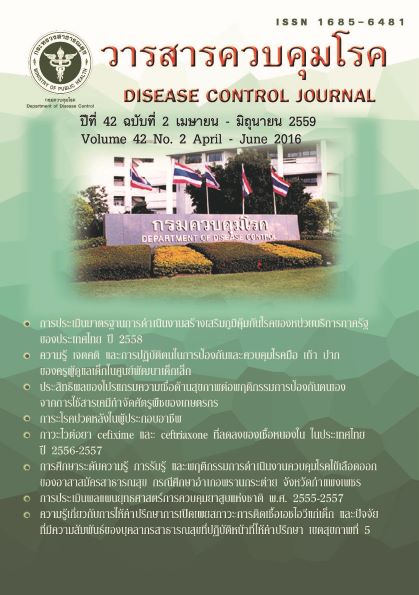Decreased sensitivity of Neisseria gonorrhoeae to cefixime and ceftriaxone: Report of three cases in Bangrak hospital, Thailand
DOI:
https://doi.org/10.14456/dcj.2016.23Keywords:
cefixime, ceftriaxone, Neisseria gonorrhoeae, sensitivitAbstract
Background : Treatment failure of Neisseria gonorrhoeae infection has been reported in USA, Japan and other European countries. Our case report focus on the surveillance of cefixime and cefriaxone susceptibility in Thailand. Objective: To observe the emergence of antibiotic resistance N. gonorrhoeae by interpreting of the MICs of cefixime and ceftriaxone. Material and Method: We conduct drug sensitivity for Neisseria gonorrhoeae, particularly cefixime and ceftriaxone Minimal inhibitory concentrations (MICs) of Neisseria gonorrhoeae by using E-test method in selective media. Result: The first case was heterosexual man came to hospital with symptoms of dysuria and discharge from urethra. The second case was woman who was the partner of first case came to hospital without any signs and symptoms. The third case was homosexual man came to hospital with generalized rash, no dysuria or discharge. All three cases, bacterial culture revealed β-lactamase negative N. gonorrhoeae. The MICs of cefixime were ranging from 0.064-0.125 μg/ml and the MICs of ceftriaxone were 0.064 μg/ml. All patients were treated and fully recovered. Conclusion: to all of the reported cases, N. gonorrhoeae strains were susceptible to cefixime and ceftriaxone, but there was an increase of MICs of cefixime and ceftriaxone which the highest MICs in Thailand. Every hospital should pay great attention on possible occurrence of resistant strains of gonorrhoeae. Further evaluation on cephalosporin MICs to N. gonorrhoeae should be implemented in patients who are not fully recovered by initial treatment.
Downloads
References
2. Satterwhite CL, Satterwhite CL, Torrone E, Meites E, Dunne EF, Mahajan R, et al. Sexually transmitted infections among U.S. women and men: Prevalence and incidence estimates, 2008. Sex Transm Dis 2013;40:187-93.
3. Unemo M, Shafer WM. Antibiotic resistance in Neisseria gonorrhoeae: origin, evolution, and lessons learned for the future. Ann N Y Acad Sci 2011;1230:E19-28.
4. Centers for Disease Control and Prevention. Sexually transmitted diseases treatment guidelines, 2015. MMWR Recomm Rep 2015;64 (RR-03):60-8.
5. Unemo M, Golparian D, Hestner A. Ceftriaxone treatment failure of pharyngeal gonorrhoea verified by international recommendations, Sweden, July 2010. Euro Surveill [Internet]. 2011 [cited 2015 Aug 17]16:pii=19792. Available from: http://www.eurosurveillance.org/ViewArticle. aspx?ArticleId=19792
6. Unemo M. Treatment failure of pharyngeal gonorrhoea with internationally recommended first-line ceftriaxone verified in Slovenia, 2011. Euro surveill;17(25): pii=20200.
7. Ohnishi M, Saika T, Hoshina S, Iwasaku K, Nakayama S, Watanabe H, et al. Ceftriaxone-resistant Neisseria gonorrhoeae, Japan. Emerging infectious diseases 2011;17:148-9.
8. Unemo M, Golparian D, Nicholas R, Ohnishi M, Gallay A, Sednaoui P. High-level cefixime and ceftriaxone-resistant Neisseria gonorrhoeae in France: novel penA mosaic allele in a successful international clone causes treatment failure. Antimicrobial agents and chemotherapy 2012;56: 1273-80.
9. Manzano S, Lacroix LE. Catheterization of the urethra in girls. The New England journal of medicine 2014;371:1849-50.
10. Ison CA, Hussey J, Sankar KN, Evans J, Alexander S. Gonorrhoea treatment failures to cefixime and azithromycin in England, 2010. Euro Surveill 2011;16(14): pii=19833.
11. Tapsall J, Read P, Carmody C, Bourne C, Ray S, Limnios A, et al. Two cases of failed ceftriaxone treatment in pharyngeal gonorrhoea verified by molecular microbiological methods. J Med Microbiol 2009;58:683-687.
12. Bala M, Kakran M, Singh V, Sood S, Ramesh V, Dorji D, et al. Monitoring antimicrobial resistance in Neisseria gonorrhoeae in selected countries of the WHO South-East Asia Region between 2009 and 2012: a retrospective analysis. Sexually Transmitted Infections 2013;89 (Suppl 4):iv28-iv35.
13. Cockerill F. Performance standards for antimicrobial susceptibility testing. Wayne, PA: Clini¬cal and Laboratory Standards Institute; 2012.
14. Center for Disease Control and Prevention. Antibiotic Resistance Threats in the United States, 2013 [Internet]. [cited 2015 Aug 17]. Available from: http://www.cdc.gov/drugresistance/threat-report-2013/
15. bioMérieux. E-test antimicrobial susceptibility testing for in-vitro diagnostic use. Marcy-l’ Etoile: bioMérieux; 2010.
16. Ghanem KG. Gonorrhea. In: Bope ET, Kellerman R, Rakel RE, editors. Conn’s Current Ther¬apy 2011. Philadelphia, Pa: Saunders/Elsevier; 2010. p. 931-8.
17. Hook EW III, Handsfield HH. Gonococcal infections in the adult. In: Holmes KK, Sparling PF, Stamm WE, Piot P, Wasserheit JN, Corey L, et al. editors. Sexually Transmitted Diseases. 4th ed. New York, NY: McGraw-Hill; 2008.
18. Unemo M, Sjöstrand A, Akhras M, Gharizadeh B, Lindbäck E, Pourmand N, et al. Molecular characterization of Neisseria gonorrhoea identifies transmission and resistance of one ciproflox¬acin-resistant strain. APMIS 2007;115:23141.
19. Ohnishi M, Watanabe Y, Ono E, Takahashi C, Oya H, Kuroki T, et al. Spreading of a chromosomal cefixime-resistant penA gene among different Neisseria gonorrhoeae lineages. Antimicrob Agents Chemother 2010;54:1060-7.
20. Cole MJ, Spiteri G, Chisholm SA, Hoffmann S, Ison CA, Unemo M, et al. Emerging cephalosporin and multidrug-resistant gonorrhoea in Europe. Euro Surveill [Internet]. 2014 [cited 2015 Aug 17];19:pii=20955. Available from: http://www.eurosurveillance.org/ViewArticle.aspx?ArticleId=20955
Downloads
Published
How to Cite
Issue
Section
License
Articles published in the Disease Control Journal are considered as academic work, research or analysis of the personal opinion of the authors, not the opinion of the Thailand Department of Disease Control or editorial team. The authors must be responsible for their articles.


.png)



